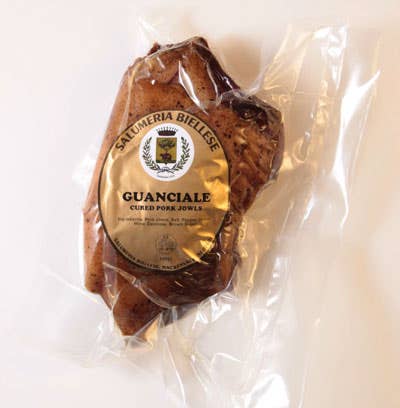
Guanciale
Cured pork jowl, known as guanciale, is an essential ingredient in many Roman pasta dishes.
Cured pork jowl, known as guanciale, is an essential ingredient in many Roman pasta dishes, including spaghetti alla carbonara (see ** Spaghetti alla Carbonara) and bucatini all'amatriciana (see ** Bucatini all'Amatriciana). But it can also be rendered and sauteed with vegetables, added to stewed fava beans, or cooked with meat or fish so that its fragrant fat suffuses the dish. Usually sold whole (pictured), guanciale has a flavor that is less salty but stronger and fattier than its meaty cousin pancetta—Italian salt-cured pork belly—and a texture that's somewhat softer. While guanciale, which can be cured with everything from black pepper to spices, is traditionally unsmoked, smoked versions are popular nowadays in Rome. Smoked guanciale isn't readily available in the United States, but Mauro Trabalza, the chef at Sora Lella, a restaurant in Rome that has an outpost in New York City, recommends a mixture of three parts regular guanciale or pancetta to one part bacon to approximate the flavor of smoked guanciale. Once hard to find in this country, guanciale is an increasingly common house-made specialty in U.S. restaurants and butcher shops.
Keep Reading
Continue to Next Story










